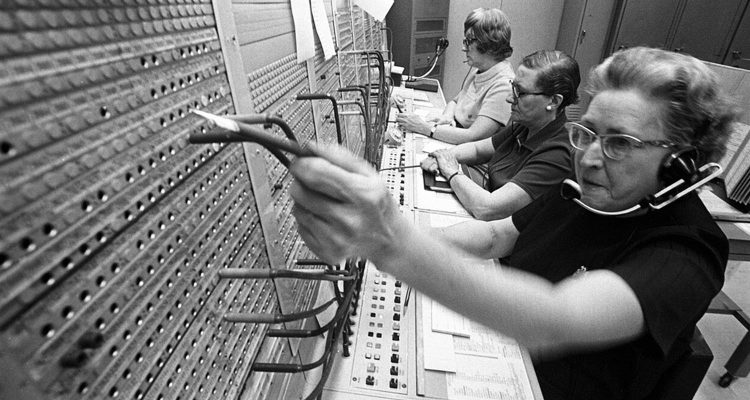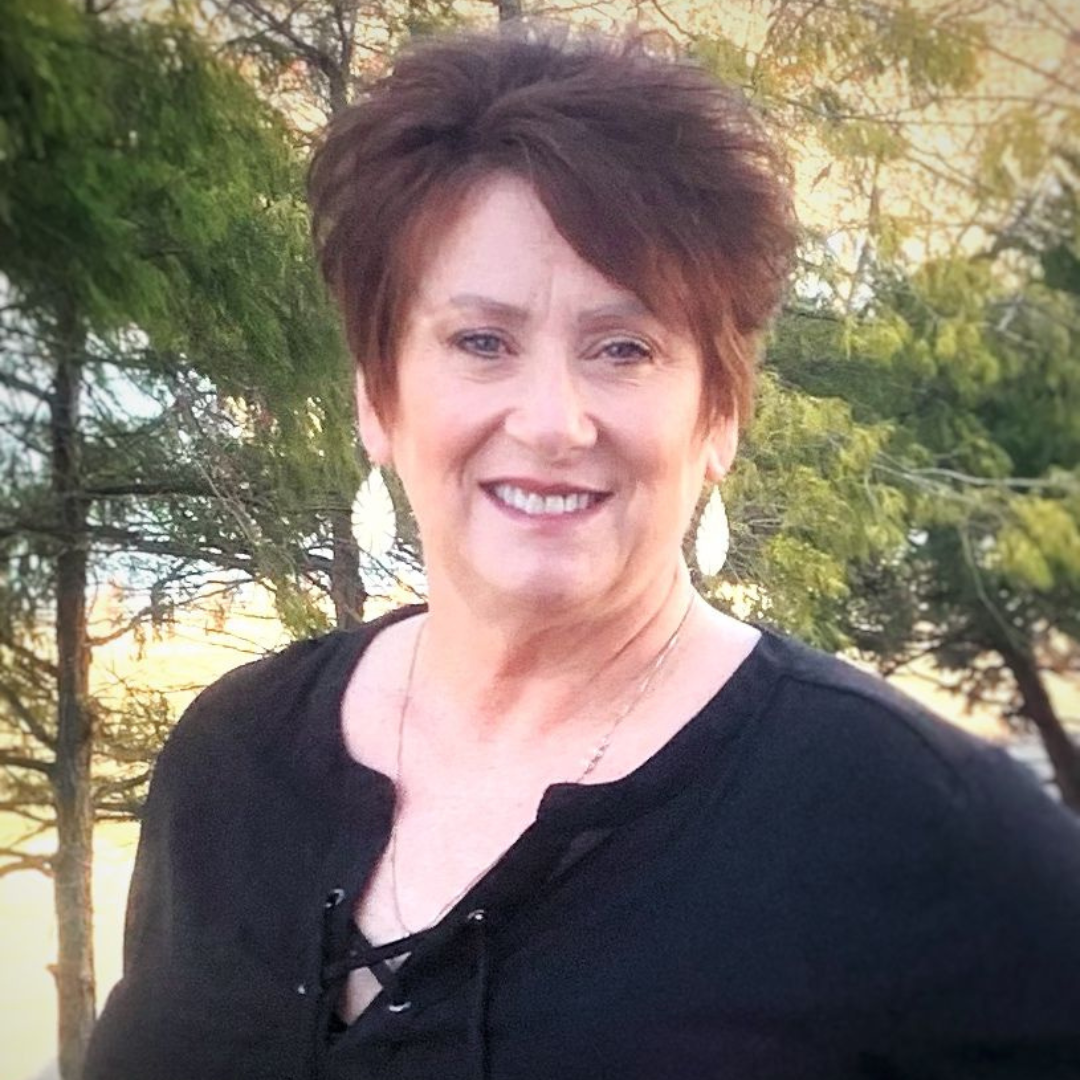But all we had, until I hit junior high, was the “party line” — about the furthest thing from a private children’s number as you could get without resorting to tin cans and string. Even more antiquated than the long-defunct rotary dial, the party line was shared by several neighbors. Though each residence had its own phone number, the line itself was a common one.
This meant that when I was dying to call Janelle or Rhonda to chat about Timmy, the cutest boy in class, I had to wait for the line to be free.
By “waiting,” I mean quietly lifting the receiver to my ear over and over again, while hearing not a dial tone but the farmer’s wife down the road gossiping endlessly with her old biddy friends from the local Homemakers’ Club. Who cared about what neighbor might be sick, or about the virtues of various methods of putting up vegetables?
I had far more pressing matters to attend to — what were my friends wearing to school tomorrow? Was there homework due in Mrs. Ball’s class? Who was sitting with whom on the school bus the following day? Like I said — very important stuff!
THE WAITING IS THE HARDEST PART
But back to waiting for dial tone, which was far worse than waiting for water to boil or for paint to dry. We would attempt to eavesdrop silently, holding our breath and covering the receiver with one hand.
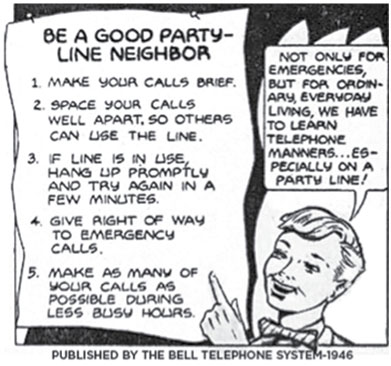
The party line of one friend’s family was shared by our homeroom teacher — this made for particularly juicy attempts at uncovering the hidden secrets of her personal life. Yet somehow, the chatty person monopolizing the airwaves was never fooled by our amateur attempts at wiretapping.
“Elsie, someone’s listening in! You kids get off this phone right this minute!” Caught red-handed, we would slam down the receiver in frustration as we continued our vigil, keeping watch by night for that elusive open line. Eavesdrop — hang up — wait 20 seconds — repeat. This cycle continued until Esther and Elsie finally gave up hope of having a decent adult conversation.
Quick as a wink, we pounced on that old rotary dial the very second our elders hung up. The trouble was that dialing seven digits took awhile. God forbid your friend’s number had lots of nines or zeros in it — that just wasted even more precious time. I can still hear the rhythmic “whoosh” of that round metal dial, which had one pitch as you turned it and another when you removed your finger and it circled back to its resting position.
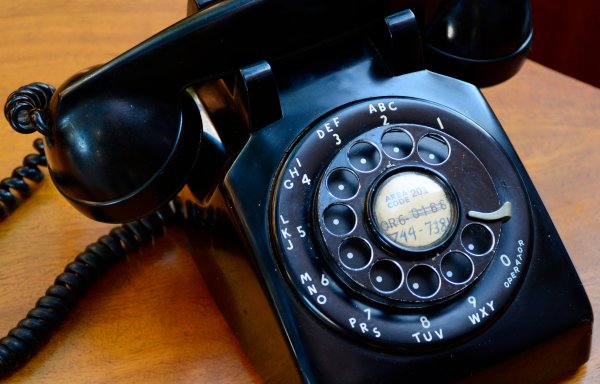
TIME AND TEMPERATURE
Our phone number from those years is deeply embedded in my memory — 547-1786. As a preschooler, I remember that my mom would sing a little song with those numbers in it to teach us our phone number; clearly, this predated Ms. Beth and SafetyTown for kids.
In those days, dialing 555-1212 would get you the voice of the Time Lady, who would inform you of the correct time. You could also call to hear the recorded current temperature and weather forecast or the local movie listings — Ma Bell’s own prehistoric version of Google. And unlike today, dialing an area code to reach the Time Lady or anyone else in your local dialing area was not necessary.
According to Areacodes.com, the system of three-digit area codes utilized today was put into effect in 1947. Because of the slowness of that old-time rotary dial, lower-number area codes were assigned to the areas with the largest populations. The rationale was that the areas with the most people in them to call should require the least amount of effort on the part of those calling them. For instance, the 213 code was assigned to various highly populated areas of California, and 212 was assigned to New York City.
The lesser-populated suburbs of New York were assigned 914, requiring those calling this “lower population/’higher number” area to deal with longer “dial pulls” when ringing up a friend or loved one there.
OPERATOR, COULD YOU HELP ME PLACE THIS CALL?
Making long-distance calls also required the assistance of the telephone operator. This cheery-voiced female would be at your service when you dialed “0,” ready to connect your call into the cryptic long-distance network. Just how that network worked was as much a mystery in days gone by as the “cloud” is to some of us today.
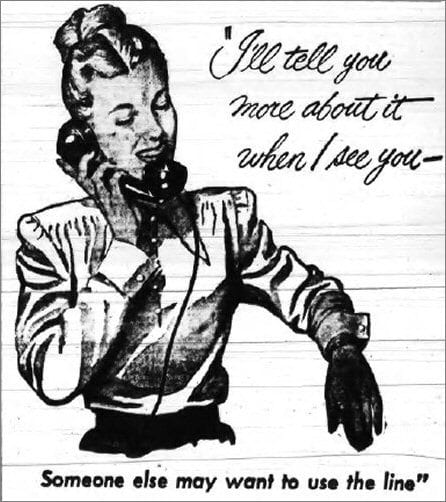 Making long-distance calls was also fairly expensive. Significant discounts were given for calling after 9 p.m. or on Sundays, so these became popular times to make a quick call to anyone living outside the Wheeling area. My beloved cousin Jill lived in various places outside of West Virginia as we were growing up, and it was a rare treat to be able to talk to her in person for five minutes on a Sunday evening.
Making long-distance calls was also fairly expensive. Significant discounts were given for calling after 9 p.m. or on Sundays, so these became popular times to make a quick call to anyone living outside the Wheeling area. My beloved cousin Jill lived in various places outside of West Virginia as we were growing up, and it was a rare treat to be able to talk to her in person for five minutes on a Sunday evening.
My phone calls were governed by various rules dictated by my parents. Calls were not to last more than 15 minutes. No one was to call for us kids after 8 p.m. Girls weren’t to call boys lest we appear “fast.” One way we attempted to bypass these rules we deemed ridiculous was by dragging the phone into the closet and keeping our voices low. If Mom was otherwise occupied, this was a fairly surefire way to add at least 10 minutes to a very important conversation.
Another talent I developed as a tween girl was the ability to answer a ringing phone in under two seconds. This kept nosy parents from knowing who was calling, on the off chance that it might be a special male caller. And since caller ID and voicemail boxes were still distant dreams of my teenage self, I found it crucial to ensure that no call went unanswered. (This stands in direct contrast to my midlife ability to allow a ringing phone to burn itself out without so much as a glance in its direction.)
WHAT DO PRINCE ALBERT AND ALMA HENDERSON HAVE IN COMMON?
But in the 1970s, that lack of caller identification allowed us to perfect our prank call skills during junior high sleepovers. We had our favorites; “Is your refrigerator running? It is? Better go catch it!” and of course the old standard “Prince Albert in a can” query. “Do you have Prince Albert in a can? You do? Better let him out!” We thought we were the high priestesses of comedy and would collapse in a puddle of laughter-induced tears at our own antics.
There was also a local window company we learned of that had the latest technology — an answering machine. Once we made this discovery, there was no end to the barrage of ridiculous messages we would leave them after business hours.
Another favorite prank call was to dial up Alma Henderson. If you are of a certain age and grew up in Wheeling, you will remember Alma as the infamous madame of a popular “cathouse” in Center Wheeling. We never knew which Alma might answer the phone; if she was in a bad mood, she would dismiss us with a string of curse words and slam down the receiver with a bang. (Today’s touchscreen phones leave a lot to be desired when it comes to a nice, satisfying old-school “hang up.”)
But if old Alma was having a good day and found herself with a few minutes to kill, she was happy to entertain questions from inquiring teenage minds about her *cough cough* “industry.” I daresay that dozens of Bridge Street girls gained a more impressive sex education from Alma than from Miss Glasgow’s health class.
MOVIN’ ON UP
Eventually, our family upgraded from a party line to a private one and from a rotary dial to a push-button style. We even took the drastic step of going from basic black to a modern beige color model. For years, I petitioned for a phone of my own in my bedroom. My parents told me when I could pay for it myself, they would consider it. My hopes soared — I was about to get a “children’s line!” But Mom laughed at the thought of that expense, and my Plan A was quickly laid to rest.
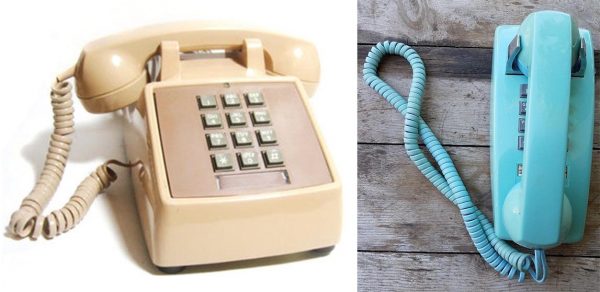
However, once I landed my first job selling concessions at the Good Zoo, I saved up enough money to purchase my own wall unit and have it installed. Mom finally relented when confronted with the fact that I was serious enough to have socked away the equivalent of two or three paychecks, and soon I was the proud owner of a groovy turquoise phone of my very own.
That purchase was one of my first lessons in delayed gratification and the benefits of hard work. It also landed me squarely in that coveted demographic of ’70s “it girl” with her own bedroom extension.
• A lifelong Wheeling resident, Ellen Brafford McCroskey is a proud graduate of Wheeling Park High School and the former Wheeling Jesuit College. By day, she works for an international law firm; by night, (and often on her lunch breaks and weekends) she enjoys moonlighting as a part-time writer. Please note that the views expressed in her writing are solely her own and do not necessarily reflect those of anyone else, including her full-time employer. Through her writing, Ellen aims to enlighten others on causes close to her heart, particularly addiction, recovery and equal rights. She and her husband Doug reside in Warwood with their clowder of rescued cats, each of whom is a direct consequence of his job as the Ohio County Dog Warden. Their family includes four adult children, their spouses and several grandkids.


